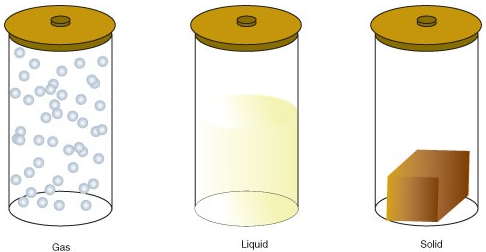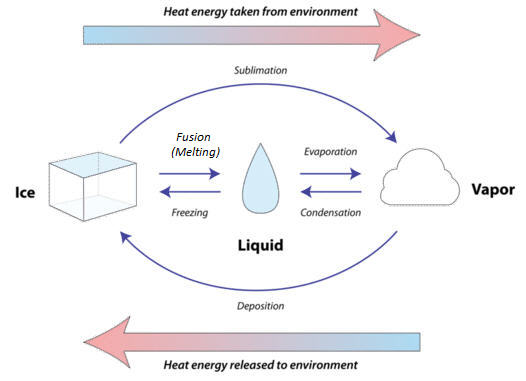Collect Pictures of Things in Different States of Matter
7.1: States of Matter
-
- Last updated
- Save as PDF
- Page ID
- 58817
Learning Outcomes
- List the three states of matter and give examples of each.
- Describe the properties of each state of matter.
- Identify and describe each type of change in state.
- Recognize that boiling and melting points vary with each substance.
- Recognize that a substance's boiling point depends on the pressure.
States of Matter
Another way that we can describe the properties of matter is the state (also called phase). The amount of energy in molecules of matter determines the state of matter. Matter can exist in one of several different states, including a gas, liquid, or solid state. These different states of matter have different properties, which are illustrated in the figure below.
- A gas is a state of matter in which atoms or molecules have enough energy to move freely. The molecules come into contact with one another only when they randomly collide. Forces between atoms or molecules are not strong enough to hold them together.
- A liquid is a state of matter in which atoms or molecules are constantly in contact but have enough energy to keep changing positions relative to one another. Forces between atoms or molecules are strong enough to keep the molecules relatively close together but not strong enough to prevent them from moving past one another.
- A solid is a state of matter in which atoms or molecules do not have enough energy to move. They are constantly in contact and in fixed positions relative to one another. Forces between atoms or molecules are strong enough to keep the molecules together and to prevent them from moving past one another.

What Determines a Substance's State?
Which state a substance is in depends partly on temperature and air pressure. For example, at the air pressure found at sea level, water exists as a liquid at temperatures between \(0^\text{o} \text{C}\) and \(100^\text{o} \text{C}\). Above \(100^\text{o} \text{C}\), water exists as a gas (water vapor). Below \(0^\text{o} \text{C}\), water exists as a solid (ice). Different substances have a different range of temperatures at which they exist in each state. For example, oxygen is a gas above \(-183^\text{o} \text{C}\), but iron is a gas only above \(2861^\text{o} \text{C}\). These differences explain why some substances are always solids at normal Earth temperatures, whereas others are always gases or liquids.
Water can take many forms. At low temperatures (below \(0^\text{o} \text{C}\)), it is a solid. It is a liquid between \(0^\text{o} \text{C}\) and \(100^\text{o} \text{C}\). While at temperatures above \(100^\text{o} \text{C}\), water is a gas (steam). The state the water is in depends upon the temperature. Each state (solid, liquid, and gas) has its own unique set of physical properties.
| Gas | Liquid | Solid | |
|---|---|---|---|
| Shape | no definite shape (takes the shape of its container) | no definite shape (takes the shape of its container) | definite shape (rigid) |
| Volume | particles move in random motion with little or no attraction to each other | has definite volume | definite volume |
| Mobility | particles move in random motion with little or no attraction to each other | particles are free to move over each other, but are still attracted to each other | particles vibrate around fixed axes |
| Compressibility | highly compressible | weakly compressible | weakly compressible |
Technically speaking a fourth state of matter called plasma exists, but it does not naturally occur on earth, so we will omit it from our study here.
Changing States
Matter constantly goes through cycles that involve changing states (also called change phases). Water and all the elements important to organisms, including carbon and nitrogen, are constantly recycled on Earth. As matter moves through its cycles, it changes state repeatedly. For example, in the water cycle, water repeatedly changes from a gas to a liquid or solid and back to a gas again. How does this happen?
Adding energy to matter gives its atoms or molecules the ability to resist some of the forces holding them together. For example, heating ice to its melting point gives its molecules enough energy to move. The ice melts and becomes liquid water. Similarly, heating liquid water to its boiling point gives its molecules enough energy to pull apart from one another so they no longer have contact. The liquid water vaporizes and becomes water vapor.

The temperature of the melting and boiling points depend on the identity of the substance and the atmospheric pressure. Each substance has its own boiling and melting points that depend on the properties of the substance, including the strength of its intermolecular forces. As an example, the values for water are given in Table \(\PageIndex{1}\). Note how the boiling point of water varies greatly with pressure.
| Altitude \(\left( \text{ft} \right)\) | Pressure \(\left( \text{atm} \right)\) | Boiling Point \(\left( ^\text{o} \text{C} \right)\) |
|---|---|---|
| -500 | 1.05 | 100.5 |
| 0 | 1.00 | 100 |
| 4000 | 0.892 | 96 |
| 7000 | 0.797 | 93 |
Contributors and Attributions
-
CK-12 Foundation by Sharon Bewick, Richard Parsons, Therese Forsythe, Shonna Robinson, and Jean Dupon.
-
Allison Soult, Ph.D. (Department of Chemistry, University of Kentucky)
Collect Pictures of Things in Different States of Matter
Source: https://chem.libretexts.org/Courses/University_of_Kentucky/UK:_CHE_103_-_Chemistry_for_Allied_Health_%28Soult%29/Chapters/Chapter_7:_Solids,_Liquids,_and_Gases/7.1:_States_of_Matter